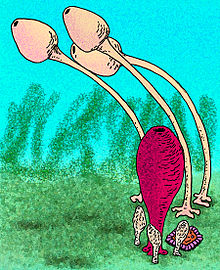| Siphonia Temporal range: 125–66 Ma PreꞒ Ꞓ O S D C P T J K Pg N Early to Late Cretaceous (Aptian to Maastrichtian) | |
|---|---|

| |
| S. pyriformis & S. tulipa | |
| Scientific classification | |
| Domain: | Eukaryota |
| Kingdom: | Animalia |
| Phylum: | Porifera |
| Class: | Demospongiae |
| Family: | †Siphoniidae |
| Genus: | †Siphonia Goldfuss, 1826 |
| Species | |
| |
Siphonia is a genus of extinct hallirhoid demosponges of the Lower and Upper Cretaceous, from about 125 to 66 million years ago. They lived in the Western Tethys Ocean, in what is now Europe.
Description
They all had distinctive pear-shaped bodies that were attached to the seafloor via a long stem. Their common name, "tulip sponges," refers to their suggestive shape, while the genus name refers to how the spongocoel (the main tube of the sponge body) runs almost the entire length of the sponge, as though it were almost a drinking straw.
Gallery
-
Siphonia lycoperdites , on display at the Museo Civico di Storia Naturale di Milano
-
 Siphonia pyriformis - Muséum de Toulouse (fr)
Siphonia pyriformis - Muséum de Toulouse (fr)
References
- Parker, Steve. Dinosaurus: the complete guide to dinosaurs. Firefly Books Inc, 2003. Pg. 34
External links
Reconstruction of S. pyriformis
Reconstruction of S. tulipa, S. pyriformis, and the related Hallirhoa costata
| Taxon identifiers | |
|---|---|
| Siphonia | |
This article about a Cretaceous animal is a stub. You can help Misplaced Pages by expanding it. |
This prehistoric sponge article is a stub. You can help Misplaced Pages by expanding it. |
- Heteroscleromorpha
- Prehistoric sponge genera
- Late Cretaceous invertebrates
- Early Cretaceous animals of Europe
- Aptian genus first appearances
- Albian genera
- Cenomanian genera
- Turonian genera
- Coniacian genera
- Santonian genera
- Campanian genera
- Maastrichtian genus extinctions
- Fossil taxa described in 1826
- Late Cretaceous animals of Europe
- Early Cretaceous invertebrates
- Cretaceous animal stubs
- Prehistoric sponge stubs